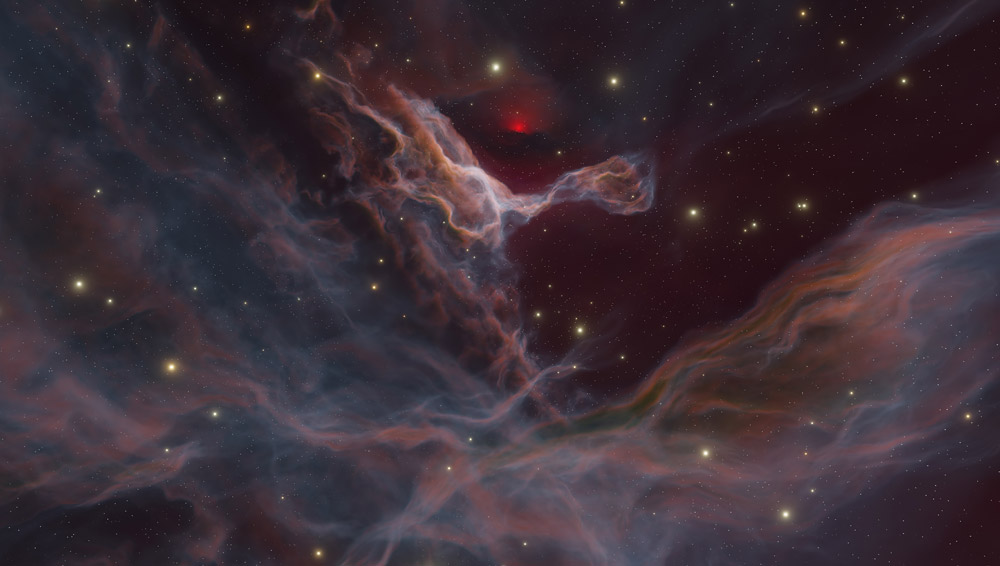A puzzling anomaly: many intergalactic gas clouds are warmer than they should be. But what warms them up is still a mystery. Now physicists can find a reason: “dark photons”. These potential dark matter particles can transform into ordinary photons under certain conditions, releasing heat in the process. According to model simulations, the observed anomaly fits perfectly with this effect, the researchers report.
When light from quasars and distant galaxies shines through intergalactic clouds of gas, the atoms and molecules in that medium leave behind distinct absorption lines in the light spectrum. The most notable of them are the hydrogen spectral lines, the so-called Alpha Lehman Lines. Because these lines are transmitted to different distances in the long wave range, depending on the distance from the hydrogen gas, the spectra often show a whole ‘forest’ of these lines.
Ambiguity around extremely broad spectral lines
However, the strange thing is that the Lyman alpha streaks of some intergalactic clouds are unusually wide. “The Lyman alpha forest is like a calorimeter: the width of the absorption lines reflects the temperature of intergalactic hydrogen,” explained James Bolton of the University of Nottingham and colleagues. According to current models, this hydrogen is mainly heated by ultraviolet radiation from stars and quasars.
For distant cosmic hydrogen clouds, line broadening is also in good agreement with the heating effect of this radiation. However, this does not apply to intergalactic hydrogen in our alien environment: even with a redshift toward z = 2, the Lyman-alpha lines are much wider than they should be. “This indicates that heating is at work here in a way that is not present in the models,” the physicists explain. According to measurements, this extra heat supplied corresponds to an energy of about 6.9 electron volts per proton.
Dark photons as originators?
But where does this energy come from? Bolton and team suspect a very special particle exists: “Excess heat could be an indication of dark photons – a candidate dark matter particlesexplains co-author Andrea Caputo of the CERN research center near Geneva. When these dark photons encounter ionized gas clouds of a certain density, resonance effects can occur, converting them into ordinary photons, releasing energy in the process.
“As a result, the dark photon can heat up the intergalactic gas, and that makes the absorption lines wider,” says Caputo. Using simulations of physical models, the researchers have now investigated whether the observed broadening of the Lehmann alpha lines can be explained by this conversion process. In particular, they analyzed the density of gas clouds at which the necessary resonance effect occurs and the mass that virtual particles should have.
The model fits the observational data
The result: intergalactic gas clouds in our immediate cosmic environment have the right intensity for the resonance effect. Thus the conversion of dark photons into their normal counterpart can occur. “Most resonant transitions occur at a redshift of z = 2,” say the physicists. “Hence, this could explain the broadening of absorption lines at low redshifts.”
In contrast, distant hydrogen clouds no longer possess the necessary density for this process, as the model suggests. Therefore, their Lehmann alpha lines deviate less than the theoretically expected values. However, even in these distant intergalactic clouds, a small part of the observed line widening could be due to dark photons, Bolton and his team hypothesized.
“The exciting thing is that there is actual evidence in the Lyman Alpha forest that the intergalactic medium at a redshift of z = 3 is also much hotter than would be expected in conventional models of ultraviolet heating,” the physicists say. You are already going down this path as well.
Not the only candidate
“Our study is the first clear indication that energy inputs from dark matter can also explain the observations,” Bolton and his team say. If dark photons exist, their model narrows their energy and therefore mass to about ten billionths of an electronvolt per square meter of the speed of light (10-14/ c2). This corresponds to about 0.1 trillion electron mass.
However, physicists also admit that they cannot rule out other explanations for the broadened spectral lines. “But if future studies rule out these traditional explanations, we may have found the first effect of non-gravitational dark matter,” comments non-gravity cosmologist Sam Witt, cosmologist at the University of Amsterdam. (Physical Review Letters, 2022; doi: 10.1103/PhysRevLett.129.211102)
Source: American Physical Society

“Tv expert. Hardcore creator. Extreme music fan. Lifelong twitter geek. Certified travel enthusiast. Baconaholic. Pop culture nerd. Reader. Freelance student.”







More Stories
Plan a cheap moon settlement from Vienna
Shepherd's cheese and feta: Are all cheeses sheep's cheese?
“The kind of stone we were hoping to find.”